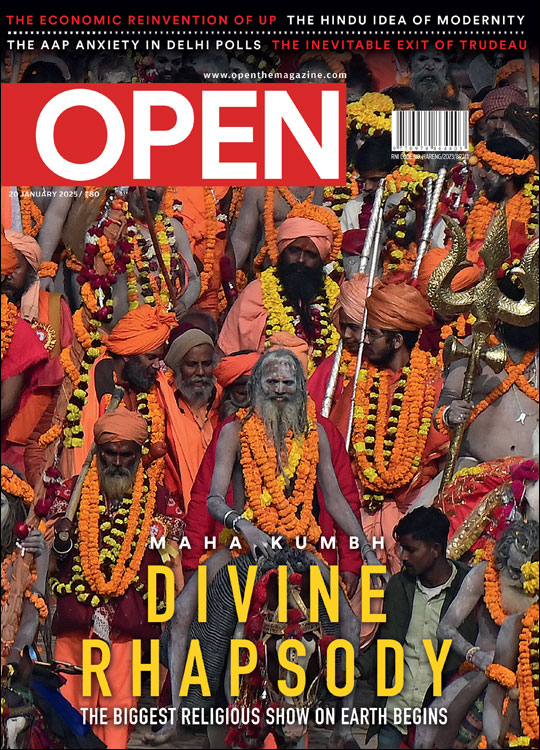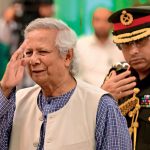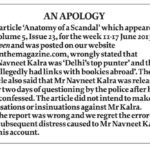God Has Left Politics
There’s proof Indians are becoming more religious. Yet the days of politics based on religion seem to be over. What happened?
 Hartosh Singh Bal
Hartosh Singh Bal
 Hartosh Singh Bal
|
09 Dec, 2009
Hartosh Singh Bal
|
09 Dec, 2009
/wp-content/uploads/2015/11/paradox-3.jpg)
There’s proof Indians are becoming more religious. Yet the days of politics based on religion seem to be over. What happened?
Religiosity is on the ascendant in this country as never before. In the last five years, daily attendance at Hindu shrines has risen dramatically. At Tirupati, it has gone up from 20,000 to 35,000. At Vaishno Devi, annual attendance has gone up from 5 million in 2004 to 7.7 million in the first 11 months of this year. But the Bharatiya Janata Party (BJP), stuck in New Delhi debating the Liberhan report in the backdrop of what could have been, has found its vote share in consistent decline over the past decade. In the Indian general election held earlier this year, it dipped to its lowest level since the party shot to prominence in 1991. If today the party is in shambles, offering little hope even to its most committed supporters, it is because it has failed to ‘harvest the souls’ that according to conventional wisdom should have been the saffron party’s for the taking.
This paradox, India’s increasing religiosity and a right wing in terminal decline, is uniquely ours. Across the world, the growth of middle-class religiosity fuelled by consumerism has strengthened right wing movements. Countries such as Turkey, which have seen a boom in the economy, have responded by voting in right wing governments to power, and in the US, the growth of evangelism has benefitted the Republicans.
For well over a decade, this was also the trend in India. In 1987-88, the telecast of Ramayana on national television—Doordarshan had a broadcast monopoly then—gave an impetus to the Vishva Hindu Parishad’s (VHP’s) Ram Janmabhoomi movement. It was this temptation of numbers that lured Lal Krishna Advani into launching his 1990-91 Rath Yatra to usher in Ram Rajya.
For observers such as Chandan Mitra, journalist and Rajya Sabha MP representing the BJP, the rise of the saffron party coincided with a ‘surge in pop religiosity’. As he says, “Advani himself has written about how the telecast of the Ramayana helped the movement. I would certainly say that this was true from 1989 to 1999.” And then, something seems to have changed.
THE NEW RELIGIOSITY
The spectacle of what is called religion, or at any rate organised religion, in India and elsewhere has filled me with horror, and I have frequently condemned it and wished to make a clean sweep of it. Almost always, it seems to stand for blind belief and reaction, dogma and bigotry, superstition and exploitation, and the preservation of vested interests.– Jawaharlal Nehru
The conventional belief, and it is a belief that seemed to have survived well into the last century, was that education and increasing prosperity would inevitably result in the decline of religious observance, even religion. But it is not a belief that has held up. Since then, sociologists have increasingly come to see religion as a basic human need. Meera Nanda, in her book, The God Market: How Globalisation is Making India More Hindu, sums this up through the career of Peter Berger, a sociologist of religion: ‘He wrote his path-breaking book, The Sacred Canopy, in 1967, in which he showed why the decline of religion was inevitable in modern industrial societies. Almost thirty years later, in 1999, he edited a book titled The De-secularization of the World, in which he recanted his belief in secularisation and accepted that the world was actually becoming more religious as it was becoming modern.’ Berger went on to note that not only is the world becoming more religious, it is becoming more religious in old-fashioned ways which do not underplay miracles and supernatural elements.
This is apparent in India today, where the new religiosity shares little with the idea of an abstract Creator propounded by Hindu sects such as the Arya Samaj. The explanation lies in the word ‘market’ that figures in Meera Nanda’s title, and goes back to a suggestion by Adam Smith. Teachers of religious doctrines, this exponent of the free market noted, ‘may either depend altogether for their subsistence upon the voluntary contributions of their hearers, or they may derive it from some other fund to which the law of their country may entitle them; such as a landed estate, a tithe or land tax, an established salary or stipend.’ He then observes, ‘Their exercise, their zeal and industry, are likely to be much greater in the former situation than in the latter.’
It is an idea that has been elaborated by modern sociologists such as Rodney Stark who state that religiosity is not simply a question of demand by a rising middle class, there is also a supply that caters to the demand. Paradoxically, the absence of a State Religion, and the freedom to practice any religion, creates a free market of sects that most efficiently caters to this demand. Welcome to this God Market—given that the demand for religion always exists, it is the supply of religious variety that actually increases or decreases religiosity. And countries such as the US and India are prime examples of this trend.
Meera Nanda argues that the absence of a State Religion in India and reforms against the most pernicious effects of caste have actually come together to produce what is the biggest God Market in the world. A 2007 study by the Centre for the Study of Developing Societies (CSDS) found that among Indians, ‘The level of religiosity has gone up considerably in the last five years. While 30 per cent said they had become more religious during the last five years, only 5 per cent mentioned in the negative… urban educated Indians are more religious than their rural and illiterate counterparts… religion has increased more in small towns and cities than in villages.’
THE PARADOX
In much of the world, this phenomenon has been tied to the strengthening of right wing politics. In India, on the other hand, points out sociologist Ashis Nandy, “Poll after CSDS poll has indicated that there is no relationship between Hinduism and the BJP. For the first time in the last election, we found a high correlation between the two in the state of Gujarat. But that is one state at one time.” The CSDS polls do not go back to the early 1990s, but these trends certainly seem to be at odds with what had transpired back then.
Of course, elections are rarely ever decided by a single factor, and in India local issues matter a huge deal. But even so, the data is perplexing, and no one would have predicted this trend at the height of the BJP’s ascendance in 1999, a year after it won power. Even if people give primacy to local issues, the BJP could have at least hoped to have seen some gains. If the BJP today is tearing itself apart, it is because senior leaders themselves are unable to explain this phenomenon or find ways for the party to cope with it.
To make sense of this, it is worth going back to 1989. The rise of political Hinduism was marked by the turmoil of the 1980s. The violence in Punjab had laid siege to Delhi, caste aspirations were rising, the Shah Bano case made it possible to raise charges of minorityism against the Congress, Kashmir was on the boil, and the very future of the country seemed at stake. At the same time, a middle class that was not simply made up of bureaucrats and their families was coming into existence, thanks to the first wave of economic reforms under Rajiv Gandhi. The telecast of Ramayana took place in this context to a populace that was certainly not inured to technology in the same way we are today. The BJP’s Ram Janmabhoomi movement fed the sense of turmoil as well as the new religious awareness that technology had created.
For Ashis Nandy, a transition took place from traditional Hinduism that was localised, a village religion where the primary devotion had been to a village deity tended to by the village priest, to a relatively ‘generic Hinduism’. In his view, it has always been the case that those moving out of the village and joining the middle class have been placed in a dilemma—for, a Hindu from Kerala bereft of the village context finds himself in the same situation anywhere, whether he is in Dubai or Assam, and at this stage, a widely recognisable Hinduism is what comes to his aid. And in the late 1980s, in the figure of Lord Ram and the political movement launched in his name, such a Hinduism consolidated its hold over the emerging middle class.
But over a period of time, this political Hinduism that was national in its scope could hardly cater to the same emotional and spiritual demands that a village deity once fulfilled. This is where the God Market has stepped in—to offer that old consolation. But while it is one thing to say that market processes have recreated that diversity among a new class, in its essence this is an entirely new phenomenon. Gurus, deities or ashrams are no longer a matter of inherited faith; people are actively making choices among a bewildering supply on offer, and the results are all around us.
Sri Sri Ravishankar’s Art of Living classes, for example, have seen enrolment increase 15 per cent year-on-year since 2003. On Thursdays, across the metros, thronging crowds and slow-moving traffic mark out any Sai Baba temple. Urban astrologers have swarms waiting to consult them. The calendar and day’s clock are being parcelled out into auspicious and inauspicious phases. The most popular divinity in the Hindu pantheon today, according to some news reports, is Shani Maharaj, the neutraliser of any negative impact of the planet Saturn.
In a 2007 series on religions across the world, The Economist had observed that, ‘When it came to marketing pizzazz, the trendier Hindu ashrams are more than a match for America’s pastorpreneurs’.
THE FAILED HARVEST
Why is it, though, that adherents of the new religiosity have not voted BJP? Certainly, as the numbers show, the BJP has not been able to harvest these souls. The answer actually lies in two factors coming together: the free play of the God Market and a fast expanding economy.
On its own, neither factor would suffice to contain the rise of right wing religious politics. In Turkey, a resurgent economy has led to the emergence of the right wing AKP party. Unlike the BJP, the AKP continues to attract support, a major factor in its favour being the absence of a God Market in that constitutionally secular republic. The Turkish state, in fact, is fiercely secular in its insistence of a complete separation of the State from religion, and its military establishment upholds General Ataturk’s legacy by allowing Islam little or no play in the public domain. In such circumstances, the AKP has used issues such as a ban on the wearing of headscarves in universities to fuel its growth. India, in contrast, steers clear of State-enforced secular fundamentalism. While many may bemoan the Hinduisation of public spaces and the blurring of lines between the State and religion, this amorphous formulation could well be posing a barrier to the spread of political Hinduism. Not only is the God Market actually allowed full play in India, political Hinduism is also left without traction that a sense of religious grievance, imagined or real, can provide.
In the US, where the God Market also has free play, ‘pastorpreneurs’ who have gained enormous followings have only served to strengthen the Republicans. But this evangelical Christianity has thrived in southern USA among a largely White population that feels besieged by the changing face of the country. Moreover, these religious adherents see themselves at odds with those who govern in Washington DC or make movies in Hollywood.
The increase in middle-class religiosity in India, on the other hand, is taking place among people who do not see themselves at odds with the power structure of India. If anything, they are the power structure, and Bollywood in no way mocks their beliefs—rather, it reflects them. Neither are they beleaguered by a set of cultural grievances the political right can play upon; on the contrary, they are imbued with a sense of optimism about the future.
An increasingly optimistic and expanding middle class that can pick and choose from the God Market to cater to its religious needs spells trouble for political Hinduism, and this goes not just for the rabid variety that the VHP has on offer, but anything the BJP can conjure up. The BJP’s Chandan Mitra goes so far as to say that this is a return to an Indian norm. In his view, ‘Hindu anger’ had spent itself by the time the BJP came to power in 1999. “Believe me,” he elaborates, “the average Hindu does not see his religion as connected with politics. For him, there is some dissonance when a sadhu assumes a political role and he certainly does not want a rabid Hindu party. Barring that ten-year period, he wants religion to stay out of politics. I am not surprised that as religiosity has grown, the BJP has declined. Our problem is that, fundamentally, there is actually no continuity between our core group of supporters and the people drawn to the new religiosity—I would even say they are at odds.”
In the free market of the gods, political Hinduism is stuck with declining returns.

/wp-content/uploads/2025/01/Cover_Kumbh.jpg)











More Columns
What does the launch of a new political party with radical background mean for Punjab? Rahul Pandita
5 Proven Tips To Manage Pre-Diabetes Naturally Dr. Kriti Soni
Keeping Bangladesh at Bay Siddharth Singh